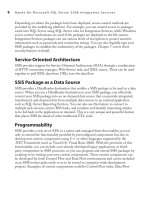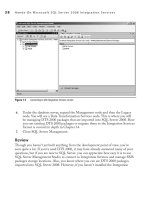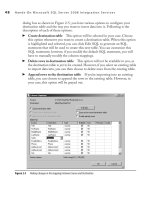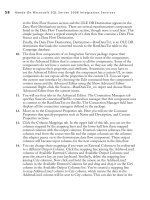Hands-On Microsoft SQL Server 2008 Integration Services part 52 pps
Bạn đang xem bản rút gọn của tài liệu. Xem và tải ngay bản đầy đủ của tài liệu tại đây (345.99 KB, 10 trang )
488 Hands-On Microsoft SQL Server 2008 Integration Services
Script Task
The Script task lets you write a piece of code to extend the package functionality and
get the job done. The ability to use your own code is provided by the Script task in the
control flow and by the Script component in the data flow. To provide an IDE, the
Script task and the Script component use Visual Studio Tools for Applications (VSTA)
in Integration Services 2008. The previous version, Integration Services 2005, used
Visual Studio for Applications (VSA) as its IDE, so if you have some scripts that are
written in SSIS 2005, you will need to upgrade them for the new environment. Refer to
Chapter 14 for details on migration issues.
Using VSTA, you can write scripts with Microsoft Visual Basic 2008 or Microsoft
Visual C# 2008. If your business rules are already coded in different .NET-compliant
languages or you prefer to write code in a different language, you can compile it into
a custom assembly and call it within the Script task, as it can call the external .NET
assemblies quite easily. The Script task allows you to leverage the powerful .NET
libraries also. The code written in VSTA is completely integrated with Integration
Services—for example, the breakpoints in VSTA work seamlessly with breakpoints in
Integration Services. Before you run a package containing a Script Task, you do need to
make sure that the VSTA engine is installed on the computer.
So, whether you want to achieve extra functionality or use existing code, the Script
task provides enough facilities to allow you to accomplish your goals.
Hands-On: Scripting the Handshake Functionality
In a classical data warehousing scenario, it is quite common to use control or handshake
files to let the processes know whether the operations upstream or downstream have
completed. In our test scenario, we have a mainframe process that copies the files into
a folder and stamps the handshake file with different strings based on the current status
of the process. As the files could be big, depending upon what has been extracted—i.e.,
daily, weekly, monthly, or yearly data—we do not want to start loading the file that is
still being written by this upstream process. Before loading the data file, the mainframe
process stamps the handshake file with the LOADING string, and on completion of
data loading into the data file, it stamps the file with the OK string. When the SSIS
package starts, we want to check the string in the handshake file first; if it is OK, the
package should stamp the handshake file with the PROCESSING string and should
start processing. And after completion of processing, it should stamp the file with the
UPDATED string so that the mainframe process knows that the data of the previous
day has been processed.
Chapter 11: Programming Integration Services 489
Method
As you can make out, it is not easy to implement the preceding requirements in SSIS
using prebuilt components, but on the other hand, they can be implemented quite
easily using the Script task. The logic required is shown in the Figure 11-1. In our
scenario, we will use HandshakeFile.txt file as the control file that has been saved in the
C:\SSIS\RawFiles folder and the RawDataTxt.csv file as the data file saved in the same
folder. You’ve already imported this data file in Chapter 2. The logic of the branches
shown in the figure will be implemented with the help of a variable HandshakeMessage
that will be created in our package. In this exercise, we will focus more on the Script
task; the rest of the items you should be able to implement yourself by now.
Exercise (Working with Script Task GUI)
We will add a Script task in the package to read the handshake file.
1. Create a new project in BIDS with the following details:
Template Integration Services Project
Name Programming SSIS
Location C:\SSIS\Projects
Figure 11-1 Work flow for handshake exercise
Status in the handshake
file?
-Stamp PROCESSING
-load data
Stamp UPDATED in the
handshake file and finish
Do nothing
OK
ELSEUPDATED
OK
ELSE
Check status
after 1 hour
490 Hands-On Microsoft SQL Server 2008 Integration Services
2. When the blank solution is created, rename the package Extending SSIS with
Script Task.dtsx and click OK in the confirmation dialog box.
3. Create a variable called HandshakeMessage at the package scope.
4. Drop a Script task from the Toolbox onto the Control Flow pane and double-click
to open the Script Task Editor.
5. Set the Name and the Description as follows in the General page:
Name Determine workflow using Handshake
Description This task sets HandshakeMessage variable that is used to determine the package control flow.
6. You can set the preferred programming language in the ScriptLanguage field.
Change it to Microsoft Visual Basic 2008 as shown in Figure 11-2.
Figure 11-2 Script Task Editor
Chapter 11: Programming Integration Services 491
7. Entry point is the method that is called when the Script task runs. Specify the
entry point name in the EntryPoint field. When you click Edit Script, the VSTA
development environment is launched and a script project is created from the
script templates based on the language you’ve specified in the ScriptLanguage
field. This auto-generated script generates the ScriptMain class as the default
class, which further contains a public subroutine or method called Main that acts
as an entry point for the script. Make sure that the name of the public subroutine
or method Main is the same as the value specified in the EntryPoint field at all
times, in case you choose to change one later on.
8. The next two fields allow you to list variables that exist in the package and you
want to access in your script. You can specify multiple variables in either of these
fields by using a comma-separated list. As the names indicate, you can have either
read-only access or read/write access to the variables, depending upon which field
you choose to list them in. This is a cool method to exchange values between
the package and your script. Though the script is a part of the package and gets
saved within the package, yet it has its own object model: ScriptObjectModel,
represented by the Dts object, that allows interaction with the package objects
outside the Script task. We will study the Dts object in a bit more detail later
on when we work on the script, but for the time being just remember that
the Dts object makes the package objects such as variables accessible to you
while working in the script. The variables listed in the ReadOnlyVariables
and ReadWriteVariables fields are referred using the Variables property of the
Dts object, and the Script task locks the variables for read or read/write access
transparently. The code example in this case would be as follows:
Dim strScriptVariable As String = Dts.Variables("varPkgVariable").
Value.ToString
There is another way to access variables from within the script. You can use the
VariableDispenser property of the Dts object within the scripts. In this method, you
don’t use ReadOnlyVariables and ReadWriteVariables fields in the Script task GUI;
rather, you lock the variables for read or read/write access using your code. While
using the VariableDispenser property is a standard way of accessing variables within
scripts, it requires a bit more code to access a variable than the earlier method. Look
at the following code example using the Dts.VariableDispenser method that shows
much more code than the Dts.Variables method.
Dim vars as variables
Dts.VariableDispenser.LockOneForRead("varPkgVariable", vars)
strScriptVariable = vars("varPkgVariable").Value.ToString()
vars.Unlock()
You may prefer to use the earlier method, as that is more convenient, though
the Dts.VariableDispenser method is the recommended method to use. First, in
the earlier Dts.Variables method you specify variables in the ReadOnlyVariables
492 Hands-On Microsoft SQL Server 2008 Integration Services
and ReadWriteVariables fields in the GUI; however, if the variables do not exist at
design time and gets created only at the run time, you can’t use this method. In such
cases, you must use the Dts.VariableDispenser method, as this method locks the
variables only when the code needs them and it doesn’t need to know beforehand
whether the variables existed or not. Second, as you can control release of locks in the
second method and can release them more quickly for access to the variables by other
concurrent processes, this can be the more efficient method to work with. The first
method—i.e., Dts.Variables—does not release locks until the task has completed, and
that obviously, in some cases, will be blocking other processes.
We will use the Dts.Variables method in our script to keep things simple, so let’s
specify the variable in Script Task GUI as a first step. Also, as we will need to update
the variable value, so we will use the ReadWriteVariables field. To specify a variable,
click in the ReadWriteVariables field and then on the ellipsis button and select the
check box next to the User:HandshakeMessage variable. Click OK to come back and
find the variable listed in the ReadWriteVariables field as shown in Figure 11-2.
Exercise (Understanding the Auto-Generated Script)
In this part of the exercise, you will open the scripting environment and understand the
various parts of the auto-generated code.
9. Click Edit Script. This will invoke the VSTA-based Script task development
environment. The Script task creates a blank scripting project within the VSTA
environment (Figure 11-3) using the language you specified in the GUI. This
VSTA project gets saved as a ScriptProject item inside the package XML code.
Once this project gets created, you can’t go back and change the language. Now if
you close the VSTA environment, you will see that the ScriptLanguage field has
been grayed out and you can’t change the language.
10. Look in the Project Explorer. By default the project creates a ScriptMain item
(ScriptMain.vb if you’ve selected the Microsoft Visual Basic 2008 language or
ScriptMain.cs for Microsoft Visual C # 2008). This does not limit you in any
way. You can create more items in your project such as classes, modules, and code
files, and if you need to reference other managed assemblies in your code, you can
also do that by adding a reference in your project. You can add a reference to an
external assembly by right-clicking the project in the Project Explorer or from the
Project menu bar item. Click the Project menu bar item to see what other items
you can add in the scripting project. The scripting code that is auto-generated
and the code that you add to create the required functionality get attached to the
Script task in which it resides. All the items that you add in the scripting project
get persisted inside the package, and you can organize them in the folders as you
would normally do in other development projects.
Chapter 11: Programming Integration Services 493
Note that a lot of default code has been auto-generated for you. It starts with
the comment about what the code is about and tells you that the ScriptMain is
the entry point class of the script. It will be a good practice to add comments at
various levels within your script. Replace the first line of the comment—Microsoft
SQL Server Integration Services Script Task—with the project heading—Script for
Handshake functionality.
After the comment lines, Imports statements have been added. These statements
represent the .NET Framework system libraries and make it easier to call the
functions in those libraries. Here you can add more system libraries as required in
Figure 11-3 Default Script task blank project
494 Hands-On Microsoft SQL Server 2008 Integration Services
your code. Listed next are some of the more frequently used .NET Framework
classes.
System.Data
c Used to work with the ADO.NET architecture
System.IO c Used to work with the file system and streams
System.Windows.Forms c Used for form creation
System.Text.RegularExpressions c Used to work with regular expressions
System.Environment c Used to retrieve information about the local
computer, the current user, and environmental settings
System.Net
c Used to provide network communications
System.DirectoryServices c Used to work with Active Directory
System.reading c Used to write multithreaded programs
The code contains a class that is named as ScriptMain by default. If you scroll
to the end of the code, you can notice that a public subroutine is also created
called Main. So, at run time, Integration Services calls the ScriptMain.Main
subroutine to execute the Script task. Two more subroutines have been added in
the ScriptMain class—ScriptMain_Startup and ScriptMain_Shutdown—along
with an enumerator ScriptResults that is used to enumerate the execution results.
The ScriptMain_Startup subroutine doesn’t contain much code, while the
ScriptMain_Shutdown subroutine unlocks the variables that have been locked by
the Dts.Variables collection. You can add more code to these subroutines in case
you want to perform some logic at the startup or shutdown of the Script task.
Finally, note that the subroutine Main is the place where you would add your
code as indicated by a comment line in the auto-generated code. The only line
contained by the Main subroutine sets the TaskResult. It is important to explicitly
set the execution result, as in some instances you may want to force the failure
based on an outcome in the script if you’re building a slightly more complex work
flow within a package. The Script task uses the TaskResult property to return
status information to the run-time engine, which in turn can use the return status
to determine the path of the workflow. The Dts.TaskResult gets the result value
from the ScriptResults Enumerator that has also been added in the script.
Exercise (Adding Your Code in the Script Project)
We have used the Dts object quite a few times in the previous sections, but it is time
to learn about it a bit more before we add code into the script. Integration Services
uses a class—Microsoft.SqlServer.Dts.Tasks.ScriptTask.ScriptObjectModel—called
the ScriptObjectModel class to access the package objects within the code written for
a Script task. Developers use properties and methods of the ScriptObjectModel class
Chapter 11: Programming Integration Services 495
to access the objects such as connections, variables, and events defined elsewhere in the
package. The global Dts object is nothing but an instance of the ScriptObjectModel
class and hence is used to interact with the package and the Integration Services run-
time engine. Just be clear that the Dts object is available only in the Script task and
not in the Script component, as it is inherited from the Script task’s namespace. It has
seven properties and one method as shown in Figure 11-4 and explained next.
c Connections Accesses connection managers defined in the package. e
connection manager accessed in this way stores the information such as user name
and password to connect to the data source, and you don’t have to provide these
details in your script. ey can also be utilized to access data directly in the script
to perform any data-related operation.
c Events Lets the Script task fire errors, warnings, and informational messages.
c ExecutionValue Returns additional information such as a value from your
Script task to the run-time engine. is value in turn can be used to determine the
control flow path.
c Log is is the only method of Dts object that helps to log information to any
of the enabled log providers.
c TaskResult Returns the success or failure of the Script task to the run-time
engine and determines the control flow path within your package. As explained
earlier, setting the TaskResult property is the main way to control the package
workflow, as you can force the value based on the outcome in the script and not
just on the execution status of the script.
c Transaction Provides the transaction within which the task’s container is running.
c Variables Provides access to the variables listed in the ReadOnlyVariables and
ReadWriteVariables task properties for use within the script.
Figure 11-4 The properties and method of the Dts object
496 Hands-On Microsoft SQL Server 2008 Integration Services
c VariableDispenser Provides an alternative way to access package variables
within the script. Both the Variables and the VariableDispenser properties have
been discussed in detail earlier in the exercise.
Now that you’ve learned all you need to write a script that can interact with the package,
let’s create a logic that is needed to fulfill our requirement of this Hands-On exercise—i.e.,
creating a different workflow based on the message in the handshake file for our package.
11. Add the following code below the comment “Add your code here.”
Dim strFileReader As String
strFileReader = My.Computer.FileSystem.ReadAllText("C:\SSIS\
RawFiles\HandshakeFile.txt")
Dts.Variables("HandshakeMessage").Value = strFileReader
'If the mainframe process is still loading or the previous day's
processing is still running
'Change the handshake message to ELSE for special handling in the
right most branch of the logic.
If (strFileReader = "PROCESSING" Or strFileReader = "LOADING") Then
Dts.Variables("HandshakeMessage").Value = "ELSE"
ElseIf strFileReader = "OK" Then
My.Computer.FileSystem.WriteAllText("C:\SSIS\RawFiles\HandshakeFile
.txt", "PROCESSING", False)
End If
This code reads the HandshakeFile.txt that resides in the RawFiles folder. In
real-life coding, you will be using a connection manager, probably with a variable
that provides flexibility as to where the file has been placed, to connect to the
file. The variable could be populated at run time by some other process before
the script runs, giving you flexibility and control over the process. To keep things
simple, I have used a direct connection to the file here. At this stage if you refer
back to Figure 11-1 to remind yourself of the logic we need to develop, you
will understand that this code better. The code reads the HandshakeFile.txt file
and passes the value to the HandshakeMessage variable, and if the value is OK,
then it writes PROCESSING in the HandshakeFile.txt file to implement the
middle branch logic. For the scenario where the process has been invoked while
the mainframe is still loading or the previous processing has still not finished, it
will set the value of the HandshakeMessage variable to ELSE to implement the
rightmost branch of logic.
12. Add a Data Flow task in the package and from the Script task, drag the precedence
constraint and drop it onto the Data Flow task. Double-click the precedence
constraint to open the editor. Select Expression in the Evaluation Operation field
and type the following in the Expression field as shown in Figure 11-5.
@HandshakeMessage = = "OK"
There is no space between the two equal (=) signs. Click Test to test the expression.
Close the success message and the Precedence Constraint Editor by clicking
OK twice.
Chapter 11: Programming Integration Services 497
13. Configure the Data Flow task to import the RawDataTxt.csv file into the
Campaign database. The main items you will set up in this task are described
next. If you’ve difficulty in setting up this task, refer to the code provided for this
book, as the complete code for this exercise been included.
Source Flat File Source to read RawDataTxt.csv file.
Destination OLE DB Destination to import into Campaign.dbo.RawDataTxt table
14. Drop another Script task below Data Flow task and connect both of them with
a success precedence constraint. This Script task will write the UPDATED
message in the HandshakeFile.txt file if the HandshakeMessage variable has
a value of OK and will complete the middle branch of our required work flow.
15. Configure the Script task as follows:
Name Update HandshakeFile
ScriptLanguage Microsoft Visual Basic 2008
EntryPoint Main
Figure 11-5 Setting the Expression in the Precedence Constraint Editor









